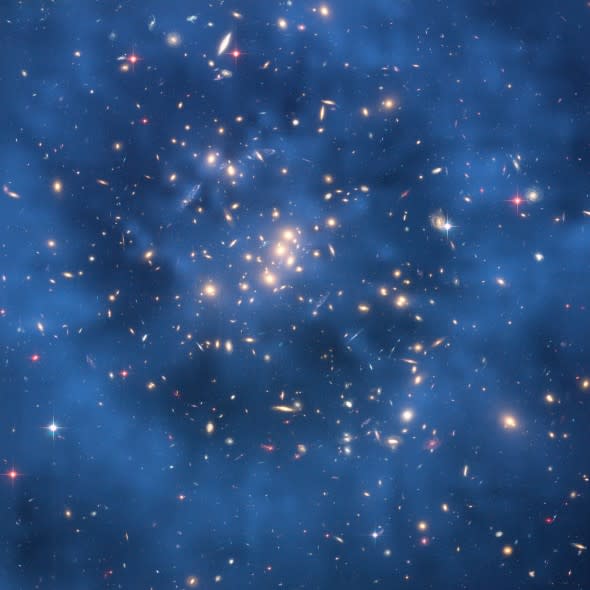China's 'Monkey King' satellite detects mysterious signals in search for dark matter
Nearly 80 percent of the universe's mass is comprised of a mysterious, invisible substance known as dark matter, which still has scientists puzzled.
While scientists currently know very little about dark matter, but recent findings from a Chinese satellite might help improve their understanding.
In a November issue of Nature, scientists reported an unexpected spectral break in their measurements of high-energy cosmic rays collected from China's Dark Matter Particle Explorer (DAMPE) satellite.
"DAMPE is a Chinese satellite mission, now operating in low Earth orbit, that is sensitive to gamma rays, or high-energy photons, and charged particles [also known as] cosmic rays," Penn State University Associate Professor of Astronomy and Astrophysics Derek Fox said.

NASA
The satellite, also dubbed Wukong after China's legendary hero Sun Wukong, or Monkey King, launched in 2015 after being developed by engineers and scientists from China, Switzerland and Italy.
Sun Wukong is a mythological figure most prominently featured in a 16th Century Chinese novel, Journey to the West.
To date, DAMPE has measured more than 3.5 billion cosmic ray particles, including 20 billion positrons and electrons with the highest energy at 100 tera-electron-volts, according to Chinese news agency, Xinhua.
Tera-electron- volts, or TeV, is a unit of energy used in particle physics with 1 TeV being roughly equivalent to the energy of motion of a flying mosquito.
Precise measurement of cosmic rays, especially at the very high energy range, is important for scientists to look for traces of dark matter annihilation or decay, DAMPE's chief scientist Chang Jin told Xinhua news agency.
This is the first time a space experiment has reported a detailed and precise electron and positron spectrum up to about 5 TeV, according to Chang, who said the satellite detected a spectral break at 0.9 TeV and a possible spike at 1.4 TeV.
These measurements are important for scientists to better understand energetic events such as pulsars, active galaxy nuclei and supernova explosions, he added.
Nearby pulsars, or magnetized neutron stars, may be emitting electrons and positrons at these energies, according to Fox.
"Or, some other type of source is creating and accelerating electrons and positrons; or there may be high-energy electrons and positrons created due to annihilation of dark matter particles," Fox said.
"However, the data of the strange signal are still not enough. We need to collect more data to make sure it's real," Chang told Xinhua.
Invisible dark matter, and the mysterious, repulsive force of dark energy, make up nearly 95 percent of our universe, Fox said.
The visible universe is comprised of ordinary matter, or baryonic matter, and is made of electrons, neutrons and protons. All of the galaxies, stars, planets and elements that can be seen only make up 5 percent of the universe.
The relative proportions of baryonic matter, dark matter and dark energy in the universe today are best constrained by Planck mission observations of the cosmic microwave background at 4.9 percent ordinary matter, 26.4 percent dark matter, 68.7 percent dark energy, Fox said.
While scientists may not be able to see dark matter, they can observe its influences in the universe. High concentrations of matter bend light passing near them in a process called gravitational lensing, according to NASA.
The Hubble Space Telescope made observations in the late 1990s that surprised scientists when they found that the expansion of the universe was not slowing down as they originally thought. In reality, the expansion was accelerating.
This acceleration is caused by dark energy, a powerful, unseen force that repels gravity.
"Suffice it to say, the evidence in favor of both dark matter and dark energy are multifaceted and quite overwhelming," Fox said.
It is impossible to understand the patterns of temperature and polarization fluctuations in the cosmic microwave background without a universe containing the [above mentioned] proportions of baryonic matter, dark matter and dark energy to less than 1 percent precision, Fox added.
If the DAMPE scientists' findings regarding the mysterious spectral breaks are accurate, the spike could indicate the existence of an unknown particle with a mass of 1.4 TeV, according to Chang.
"Understandably, some physicists and astronomers are very excited about the dark matter scenario specifically, as we know very little about the dark matter," Fox said. "My usual response in these situations is to acknowledge that the dark matter scenario is 'very interesting if true.'"
